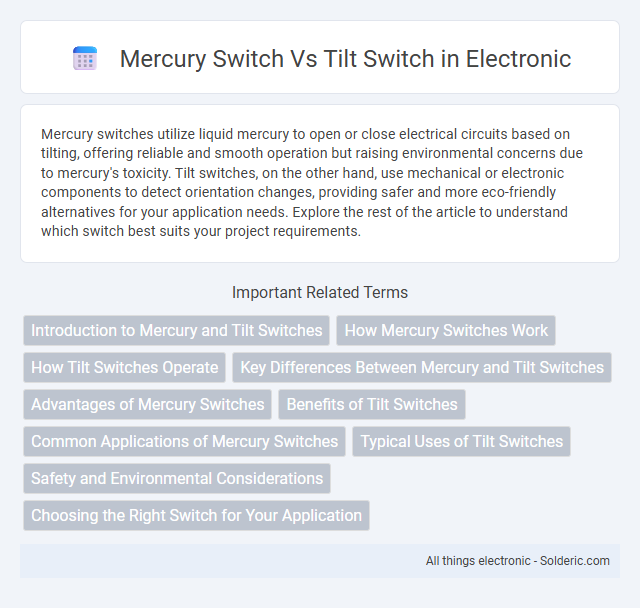Mercury switches utilize liquid mercury to open or close electrical circuits based on tilting, offering reliable and smooth operation but raising environmental concerns due to mercury's toxicity. Tilt switches, on the other hand, use mechanical or electronic components to detect orientation changes, providing safer and more eco-friendly alternatives for your application needs. Explore the rest of the article to understand which switch best suits your project requirements.
Comparison Table
| Feature | Mercury Switch | Tilt Switch |
|---|---|---|
| Operation Principle | Uses liquid mercury to complete circuit when tilted | Mechanical or magnetic mechanism to detect tilt |
| Material | Contains toxic mercury liquid | Contains metal ball, magnetic or mechanical parts |
| Durability | Long life but fragile due to glass enclosure | Robust, less fragile than mercury switch |
| Environmental Impact | High toxicity, hazardous waste concerns | Environmentally safe, no toxic materials |
| Sensitivity | High sensitivity to tilt angle | Variable sensitivity depending on design |
| Applications | Legacy automotive, thermostats, appliances | Modern electronics, security systems, toys |
| Cost | Higher due to mercury handling and regulations | Lower manufacturing and disposal cost |
| Safety | Risk of mercury exposure if broken | Safe and non-toxic |
Introduction to Mercury and Tilt Switches
Mercury switches contain a small amount of liquid mercury that completes an electrical circuit when tilted, offering reliable conductivity and durability in various applications. Tilt switches operate using a rolling ball or other components inside a sealed enclosure, activating circuits based on orientation changes. Both types are used for position sensing, but mercury switches are favored for precision, while tilt switches often provide a safer, mercury-free alternative.
How Mercury Switches Work
Mercury switches operate by using a small amount of liquid mercury inside a sealed glass or metal container that tilts to make or break an electrical connection. As the switch tilts, the mercury flows to touch the contacts, completing the circuit and allowing current to pass through. This liquid metal's high conductivity and fluidity provide reliable and sensitive activation in applications like thermostats, automotive sensors, and tilt detection devices.
How Tilt Switches Operate
Tilt switches operate by detecting changes in orientation or angle, utilizing a small internal rolling element such as a ball or mercury droplet that moves to complete or break an electrical circuit. Unlike mercury switches, which rely on the conductivity of liquid mercury to close the circuit, tilt switches typically use mechanical displacement to trigger the switch. This mechanism allows tilt switches to provide reliable activation in various positions, making them ideal for motion sensing and position detection in devices.
Key Differences Between Mercury and Tilt Switches
Mercury switches use a small amount of liquid mercury to open or close an electrical circuit based on the switch's orientation, providing reliable and precise operation due to the conductive properties of mercury. Tilt switches, on the other hand, typically contain a ball or metal contact that moves within a sealed enclosure to activate the circuit in response to changes in angle or inclination. Key differences include the use of liquid metal in mercury switches versus solid contacts in tilt switches, environmental concerns due to mercury toxicity, and variations in sensitivity, durability, and application suitability.
Advantages of Mercury Switches
Mercury switches offer high reliability and durability due to their sealed design, which prevents corrosion and ensures consistent electrical contact. These switches provide smooth operation with low contact resistance, making them ideal for precise and sensitive applications. Your projects benefit from mercury switches' ability to function accurately in harsh environments and varying orientations without mechanical wear.
Benefits of Tilt Switches
Tilt switches offer enhanced safety by eliminating toxic mercury, making them environmentally friendly and ideal for modern applications. They provide reliable operation with low power consumption and can be customized for various angles and sensitivity levels. Their durability and non-mercury design make tilt switches the preferred choice in consumer electronics, automotive systems, and industrial equipment.
Common Applications of Mercury Switches
Mercury switches are commonly used in thermostats, automotive anti-lock braking systems (ABS), and industrial equipment for reliable and precise tilt detection. Their sealed design makes them ideal in environments requiring moisture resistance and electrical isolation. You can find mercury switches in applications where durability and stable performance are critical despite orientation changes.
Typical Uses of Tilt Switches
Tilt switches are commonly used in safety devices, gaming controllers, and household appliances to detect changes in orientation or position. Industrial applications include monitoring machinery tilt for operational safety and activating alarms in case of abnormal movements. Their compact design and reliable sensitivity make them ideal for automotive systems, robotics, and consumer electronics.
Safety and Environmental Considerations
Mercury switches contain toxic mercury, posing significant health and environmental hazards if broken or improperly disposed, leading to strict regulations and increasing restrictions worldwide. Tilt switches, often utilizing non-toxic materials like metal balls or reed switches, offer safer alternatives with lower environmental impact and easier recycling processes. Choosing tilt switches helps minimize contamination risks and compliance challenges associated with mercury switches in electronic and industrial applications.
Choosing the Right Switch for Your Application
Selecting between a mercury switch and a tilt switch depends on the specific application requirements such as sensitivity, environmental conditions, and safety standards. Mercury switches offer reliable, low-resistance contact in harsh environments but raise concerns due to mercury toxicity and environmental regulations. Tilt switches provide non-toxic operation with various activation angles and are preferred in consumer electronics and safety-sensitive applications.
mercury switch vs tilt switch Infographic

 solderic.com
solderic.com